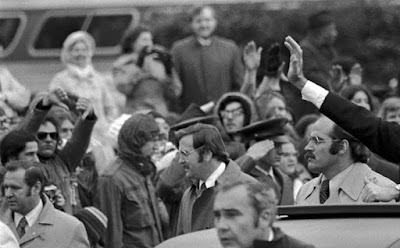
Click on pictures to enlarge.
 You may recall the Aug. 27, 2007 visit of President George W. Bush to Albuquerque and more specifically, the Village of Los Rancho de Albuquerque’s Mayor Larry Abraham’s home on Rio Grande Boulevard, for a Sen. Pete Domenici fund-raiser. I posted Aug. 28.
You may recall the Aug. 27, 2007 visit of President George W. Bush to Albuquerque and more specifically, the Village of Los Rancho de Albuquerque’s Mayor Larry Abraham’s home on Rio Grande Boulevard, for a Sen. Pete Domenici fund-raiser. I posted Aug. 28. On Aug. 30, Albuquerque Journal Politics Writer Jeff Jones wrote in a copyrighted story, “Bush Manual Shows Disparities,” that under the direction of the Secret Service, local law enforcement including Bernalillo County Sheriff’s deputies and Albuquerque Police Department officers enforced a zone of more than 750 feet to keep protesters away from the event.
On Aug. 30, Albuquerque Journal Politics Writer Jeff Jones wrote in a copyrighted story, “Bush Manual Shows Disparities,” that under the direction of the Secret Service, local law enforcement including Bernalillo County Sheriff’s deputies and Albuquerque Police Department officers enforced a zone of more than 750 feet to keep protesters away from the event.On Jan. 15, the American Civil Liberties Union filed a law suit in federal district in Albuquerque on behalf of some 150 protesters.
The suit alleges that while the protesters were kept out of the view of the president, a group of supporters were allowed mere yards from the motorcade. The ACLU charges unequal treatment of people who wish to see and send messages to their president in violation of citizen’s constitutional rights.
"There are several ways the advance person can prepare a site to minimize demonstrators," according to the October 2002, "Presidential Advance Manual." In the section, “Preparing for Demonstrators,” it reads, "First, as always, work with the Secret Service and have them ask the local police department to designate a protest area where demonstrators can be placed, preferably not in view of the event site or motorcade route." The ACLU in their filing is using the heavily redacted White House manual, as source material.
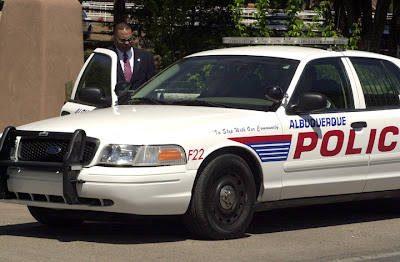 “The Secret Service makes the final calls for security at presidential events,” Bernalillo County Sheriff Darren White told the Journal, at the time. A Secret Service agent, above, confers with an APD officer during the fundraiser.
“The Secret Service makes the final calls for security at presidential events,” Bernalillo County Sheriff Darren White told the Journal, at the time. A Secret Service agent, above, confers with an APD officer during the fundraiser."I disagree with their allegations in the lawsuit," Sheriff White said, in another Journal article, “ACLU Sues Over Bush Visit Protest” written by Jones on Jan. 16. City Attorney Bob White also told Jones that APD officers did nothing wrong.
So what’s wrong with this picture?
 State Democratic Party Executive Director Laura Sanchez, above, gave a television interview the day before the event, at a sign painting session preparing for the protest. She is one of the named plaintiff’s in the ACLU suit.
State Democratic Party Executive Director Laura Sanchez, above, gave a television interview the day before the event, at a sign painting session preparing for the protest. She is one of the named plaintiff’s in the ACLU suit. American Federation of State County and Municipal Employees Legislative and Political Director Carter Bundy, is also a plaintiff. He carried: a protest sign, a cooler, and an American flag as he left the protest site. Bundy is wearing his pajama bottoms. The protest was nicknamed Pete’s pajama party, in honor of Sen. Domenici’s reportedly wearing pajama pants in the Senate office building during the 2006 Christmas break. Domenici said, at the time, that they were camouflaged hunting pants, not pajamas.
American Federation of State County and Municipal Employees Legislative and Political Director Carter Bundy, is also a plaintiff. He carried: a protest sign, a cooler, and an American flag as he left the protest site. Bundy is wearing his pajama bottoms. The protest was nicknamed Pete’s pajama party, in honor of Sen. Domenici’s reportedly wearing pajama pants in the Senate office building during the 2006 Christmas break. Domenici said, at the time, that they were camouflaged hunting pants, not pajamas.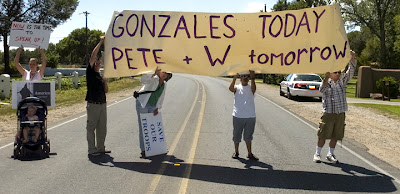 Others named as plaintiffs, above, in the ACLU suit include: Laura Paskus-Lawrence, left, with her 19-month old daughter; Stop the War Machine, whose members held this large sign, above; and Jeanne Pahls, third from left, holding and peering out from under the sign. At the far right end of the sign is Bob Anderson. He is not named in the suit, but is a leader of Stop the War Machine and a former Green Party U.S. Congressional candidate for N.M. District 1 seat in 1998.
Others named as plaintiffs, above, in the ACLU suit include: Laura Paskus-Lawrence, left, with her 19-month old daughter; Stop the War Machine, whose members held this large sign, above; and Jeanne Pahls, third from left, holding and peering out from under the sign. At the far right end of the sign is Bob Anderson. He is not named in the suit, but is a leader of Stop the War Machine and a former Green Party U.S. Congressional candidate for N.M. District 1 seat in 1998.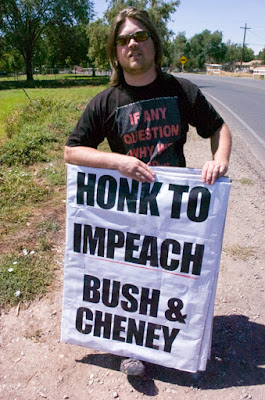 Jason Call, above, who, at the time was a Democratic U.S. Congressional candidate for N.M. District 1 seat, was attempting to see the president up close to show him his sign. Call has since withdrawn from the Congressional race.
Jason Call, above, who, at the time was a Democratic U.S. Congressional candidate for N.M. District 1 seat, was attempting to see the president up close to show him his sign. Call has since withdrawn from the Congressional race.The plaintiffs have agreed not to make individual public comments, instead directing questions to an ACLU spokesperson in New York City.
Sheriff White, who was present, said in a story, “ACLU free-speech lawsuit targets Albuquerque-area law enforcement,” by Albuquerque Tribune Reporter James Brosnan, that he could see the protestors from Abraham’s house. Jones wrote, Sheriff White added that, “the protesters were not hidden from Bush's view.”
Yet, from this vantage point, about as close as anyone was allowed to get, the wall behind this Secret Service Agent, above, who was conferring with APD officers, blocked the view of Mayor Abraham’s house.
White is equivocating. A Republican, he is now running for the First U.S. Congressional District seat being vacated by Rep. Heather Wilson, who is running for retiring Sen. Pete Domenici’s seat.
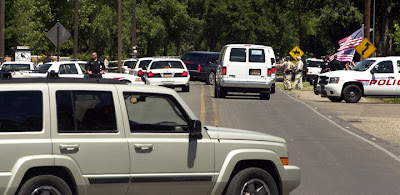 As this picture shot with a telephoto lens shows, one would be hard pressed to read the printing on the signs at Abraham’s gate. Therefore, the president would likewise have had difficulty seeing the protesters signs while sitting in his limousine. There also was a moving unmarked law enforcement vehicle that paralleled the heavily armored vehicle, partially blocking the view.
As this picture shot with a telephoto lens shows, one would be hard pressed to read the printing on the signs at Abraham’s gate. Therefore, the president would likewise have had difficulty seeing the protesters signs while sitting in his limousine. There also was a moving unmarked law enforcement vehicle that paralleled the heavily armored vehicle, partially blocking the view."Did we try to make that area as secure as possible? Absolutely," Sheriff White told the Journal. However, it clearly was not about security, because Sheriff White’s deputies violated the cardinal rule of dignitary protection; don’t watch the protected party, instead watch the crowd. The deputies, closest to the supporters, have their backs to them and are facing the president’s limousine.
Sheriff White equates a distasteful message with a security risk. Citizens who disagree with the administration have as much right to send their message, as do those who are in support. Law enforcement may not quash one, while encouraging or facilitating another.
The supporters appear to be on the street side of the utility poles, which may mean that they were not on private property as White maintains, but were on the public right of way.
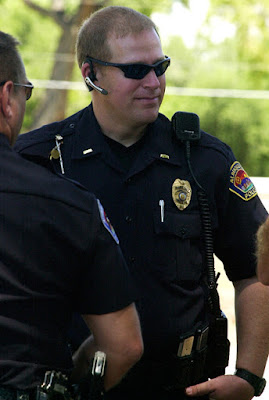 Had the American flags appeared a minute earlier, this Albuquerque Police Lieutenant would have gotten a face full of complaints for not providing equal access to citizens and the local press.
Had the American flags appeared a minute earlier, this Albuquerque Police Lieutenant would have gotten a face full of complaints for not providing equal access to citizens and the local press.Sheriff White doesn’t get it, or doesn’t care. The violation of the Constitutional rights comes from allowing the group of supporters to be closer than other citizens based on their message.
Sheriff White fails to understand the rationale behind the legal exception that allows for restricting parts of the First Amendment, specifically: speech, peaceable assembly and the right to petition government for a redress of grievances. Both protesters and supporters have equal rights.
The two legal theories that the courts use in their consideration are called the time, place and manner restrictions, and content neutrality.
The regulation is on where and when expression is made, as opposed to what is said. The First Amendment tolerates restrictions on time, place and manner. It is not tolerant of content regulations.
There are four criteria that must be met to constitutionally justify imposing time, place and manner restrictions. The restriction must be:
content neutral,
not a complete ban on a kind of communication,
the state must articulate a "substantial interest" to justify the restraint, and
the restriction must be narrowly tailored so it does not restrict anymore than it needs to, to meet the stated goal.
Sheriff White cannot get past the first criteria, content neutrality. He tries to use security as an excuse, but to do so, he has to judge the nature of the messages, pro and con.
Sheriff White was the 2004 Bush Bernalillo County re-election coordinator, when Vice President Cheney came to Rio Rancho High School to speak at a public gathering. Apparently, using “Section V. Crowd Raising and Ticket Distribution” of the Advance Manual, “Proper ticket distribution is vital to creating a well-balanced crowd and deterring potential protesters from attending events.” Sheriff White required citizens, wanting to attend, to sign a loyalty oath to the Republican Party to obtain tickets for the event.
 This is not the first time, nor is it limited to only one party, that has such limitations have been made.
This is not the first time, nor is it limited to only one party, that has such limitations have been made.The 1968 Democratic National Convention in Chicago was interspersed with demonstrators, some peaceful, some confrontational, and a few who became violent. Their protests, eventually spurred an 18-minute nationally televised “police riot.”
 Just days before the 1968 general election, then Maryland Gov. Spiro T. Agnew, the Republican Vice Presidential candidate on a final campaign tour, spoke in Albuquerque. APD officers and a Secret Service Agent block entrance to two supporters of Independent Presidential candidate Alabama Gov. George Wallace, at the Agnew event.
Just days before the 1968 general election, then Maryland Gov. Spiro T. Agnew, the Republican Vice Presidential candidate on a final campaign tour, spoke in Albuquerque. APD officers and a Secret Service Agent block entrance to two supporters of Independent Presidential candidate Alabama Gov. George Wallace, at the Agnew event.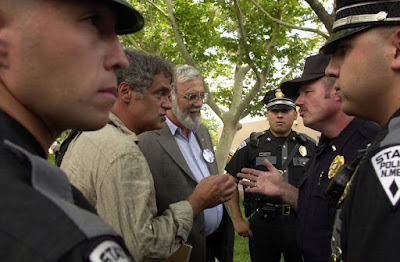 Prior to the Sept. 4, 2003 debate at Popejoy Hall on the University of New Mexico campus for the Democratic Party Presidential candidates, limitations were imposed on demonstrators supporting various candidates.
Prior to the Sept. 4, 2003 debate at Popejoy Hall on the University of New Mexico campus for the Democratic Party Presidential candidates, limitations were imposed on demonstrators supporting various candidates.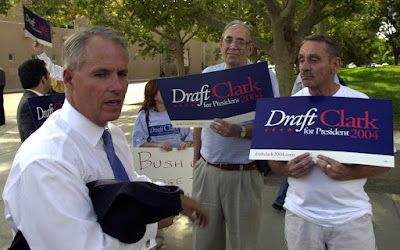 Mayor Martin Chávez, then a supporter of Sen. John Edwards, confronted a group of “Draft Wesley Clark” demonstrators on the mall and then spoke to a UNM Police Lieutenant.
Mayor Martin Chávez, then a supporter of Sen. John Edwards, confronted a group of “Draft Wesley Clark” demonstrators on the mall and then spoke to a UNM Police Lieutenant.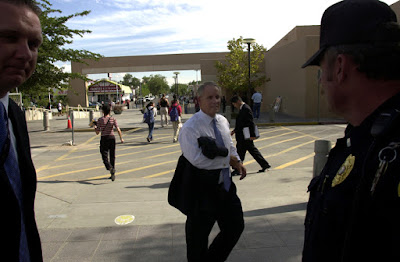 Chávez then walked past the group, and the officer challenged Gen. Clark’s supporters. He ordered them to move more than a block away and out of sight of the partisan Democratic crowd.
Chávez then walked past the group, and the officer challenged Gen. Clark’s supporters. He ordered them to move more than a block away and out of sight of the partisan Democratic crowd. The only difference between the supporters and the people attending was, they were carrying campaign posters in a public place and they did not have tickets for the event.
The only difference between the supporters and the people attending was, they were carrying campaign posters in a public place and they did not have tickets for the event.Law enforcement protective details are often placed in positions where their obligation is conflicted by personal and sometimes political considerations. If it were up to the Secret Service, the president would never leave the relative security of the White House. Therefore, the further away anyone is from the president, the better. However, the Secret Service is also pragmatic; they recognize that those under their protection are political animals, dependent upon public contact.
The White House Advance manual encourages “…deterring potential protestors from attending events.” To the Secret Service, following that political request actually makes their job easier; one less potential problem, the possible disruption by demonstrators.
The Secret Service’s primary role is to protect the president from physical or murderous attacks.
The Secret Service has its own protocols, separate from the White House Advance manual. It is, for obvious reasons, not widely distributed. It has been developed, altered and updated over the years. From my experience, the Service has always maintained a tight control on access to the public. However, there were few previous hints that the Service was being used as blatantly political as it is with this administration.
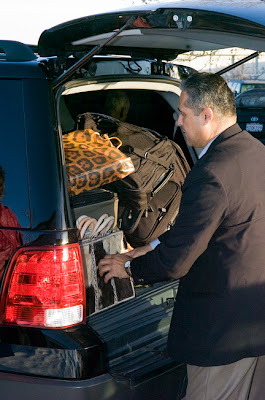 Security details are often placed into situations where they become personal valets. Here, Lt. Mark Romero, head of the New Mexico State Police Governor’s Security Detail, loads luggage in the rear of a state vehicle after Gov. Bill Richardson’s return from his diplomatic trip to Sudan, where he helped broker a cease-fire in Darfur. The NMSP motto "Pro Bono Publico" or "For the Public Good," is inconsistent with personal service. This is not a job for the State Police; rather it’s a task that should be done by some personal aide, or political operative. Remember, President Jimmy Carter carried his own bags.
Security details are often placed into situations where they become personal valets. Here, Lt. Mark Romero, head of the New Mexico State Police Governor’s Security Detail, loads luggage in the rear of a state vehicle after Gov. Bill Richardson’s return from his diplomatic trip to Sudan, where he helped broker a cease-fire in Darfur. The NMSP motto "Pro Bono Publico" or "For the Public Good," is inconsistent with personal service. This is not a job for the State Police; rather it’s a task that should be done by some personal aide, or political operative. Remember, President Jimmy Carter carried his own bags. My Take
My TakeIt’s not just about protesters.
It is also about the phrase, “…or of the Press…” the First Amendment’s section that prohibits government, originally through, “Congress shall make no law…” from affecting the freedom of the press.
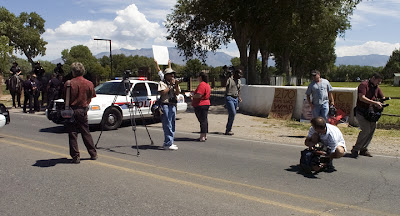 By the time the president left the event, there were only a half a dozen demonstrators left; while there were almost twice as many members of the local media still present.
By the time the president left the event, there were only a half a dozen demonstrators left; while there were almost twice as many members of the local media still present. KOAT TV Photojournalist J. Paul Hyso, above, turned his back on the motorcade and shoots one of his trademark low-angle shots of one of the few remaining protesters at the event.
KOAT TV Photojournalist J. Paul Hyso, above, turned his back on the motorcade and shoots one of his trademark low-angle shots of one of the few remaining protesters at the event.I grant the need for providing security to the president when he is in the open, but the cordons imposed here, were excessive. There is no reason, once the president is inside his rolling safe, with its four inches of armor plating, to impose a restriction on where citizens of this country stand, observe, report, photograph, or express themselves, except to violate the Constitution.
The final phrase of the First Amendment, “…or the right of the people…, and to petition the government for a redress of grievance.”
The president represents “the government,” the demonstrators have a right to petition, carry signs, shout and protest their grievances directly. In an ironic twist that only a constitutional absolutist could embrace, the first amendment petition clause would not apply to supporters; they would be covered by the free speech clause. Petition is an additional and specific right. Redress of grievances means to set things right. In order to be considered, to set things right, the government must be aware. Petition can come in formal and informal ways. The government itself often generates the grievances upon which redress is sought.
I am not trying to encourage such restrictions. However, had the Sheriff’s Deputies not allowed the supporters to stay where they were, the grounds for this suit would not have gotten the needed traction.
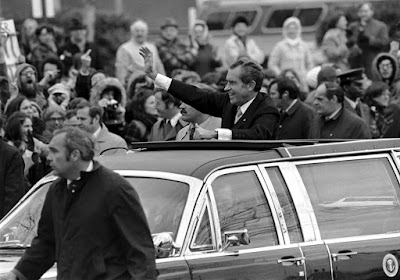 President Richard Nixon, a man who had to resign, in disgrace, because he criminally tried to destroy his political enemies, was even willing to withstand acts of ridicule and indignity, as seen here during his second inaugural parade Jan. 20, 1973, unlike the current president.
President Richard Nixon, a man who had to resign, in disgrace, because he criminally tried to destroy his political enemies, was even willing to withstand acts of ridicule and indignity, as seen here during his second inaugural parade Jan. 20, 1973, unlike the current president.
No comments:
Post a Comment